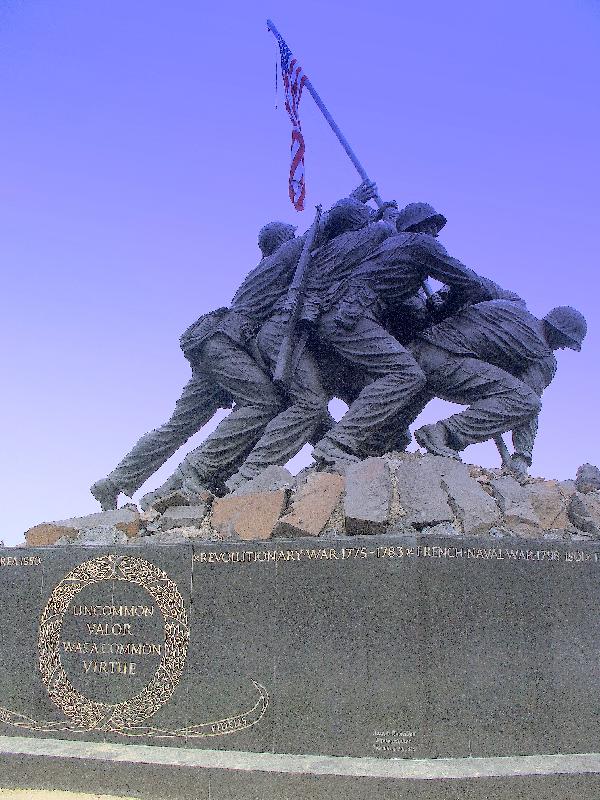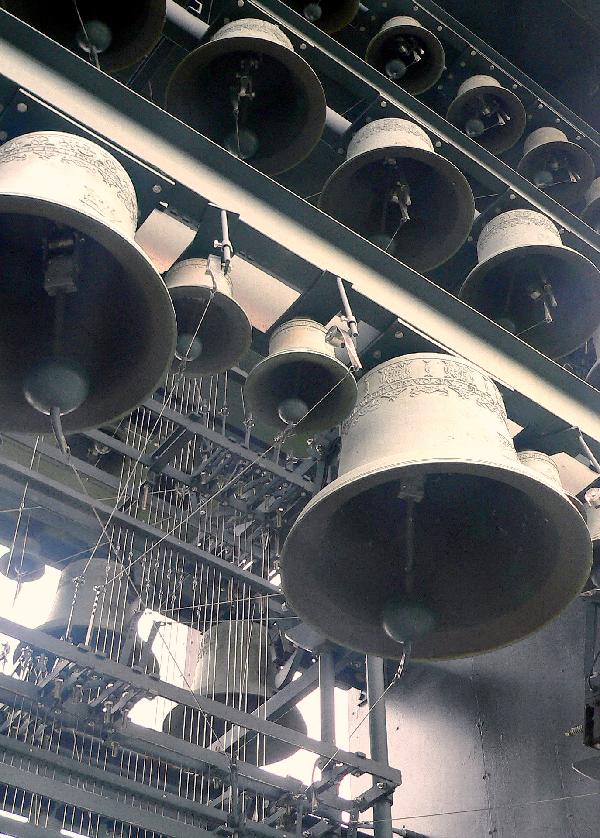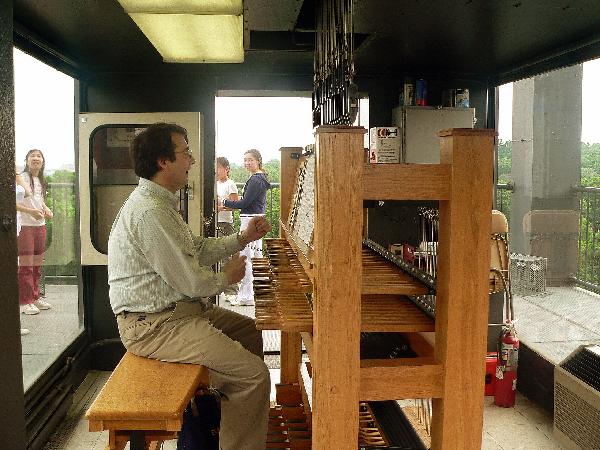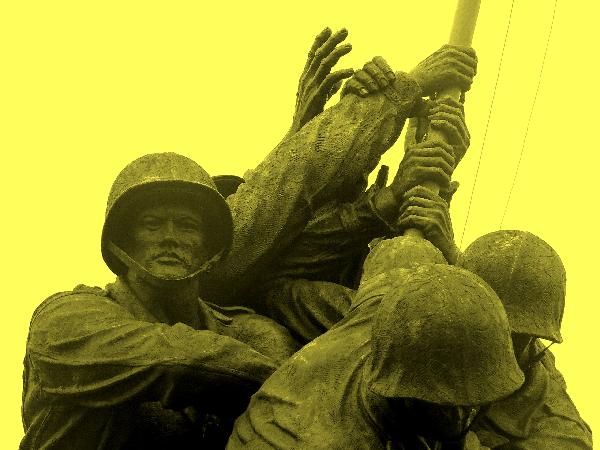NPS GWMP Website; Local GWMP Website; Local USMC MEM Website; Local Netherlands Carillon Website
 WHAT IS IT?
WHAT IS IT?Two adjacent and imposing structures located in Arlington, Va. along the George Washington MEM PKWY and overlooking Washington, DC. The US Marine Corps MEM is better known as the Iwo Jima Memorial because it recreates the famous World War II photograph of five Marines raising an American Flag atop Mount Suribachi.
The Netherlands Carillon is a 135-foot bell tower donated to the US by the Dutch. The tower and its 50 handcrafted bells represent thanks for American intervention in World War II.
BEAUTY (7/10)
The Carillon and the Marine MEM seem like strange neighbors. The steel Carillon tower guarded by a pair of regal stone lions is sleek, rectangular, modern and abstract; the bronze Memorial is a traditional sculpture so intent on realism, sculptor Felix W. de Weldon asked the three surviving flag raisers to pose for the statue. Just what do they have in common?
The contrasting designs are both huge and awe-inspiring; one just gets more attention. Tourists slowly circle the 78’ tall Marine Memorial, staring up at the larger than life Marines, quietly ticking off the names of battles that wrap around the base. Few visitors seem to take the extra steps to the Carillon tower, where a 360-degree panorama featuring our nation’s capital, the Arlington Cemetery and the mighty Potomac reward those that make the climb.
HISTORICAL INTEREST (5/10)
Although a moment captured by photographer Joe Rosenthal during the Pacific campaign of World War II inspired the sculpture, the Marine Corps Memorial stands as a tribute to all Marines who have given their lives to the United States. Its huge granite base lists every principal Marine engagement since the founding of the Marine Corps in 1775.
Michael and Gab were both surprised to learn that the Memorial was erected and officially dedicated in the fall of 1954. We hadn’t realized the tribute materialized so quickly after the 1945 event.
By 1954, the 49 bells for the Carillon were completed and sent from the Netherlands to Washington DC where they were placed in a temporary tower in West Potomac Park. The idea for this rather large gift was borne a few years prior and met with the approval of both the people of the Netherlands and their Queen Juliana. In 1952, Queen Juliana presented President Truman with a small bell as a token of the tower to come.
The Carillon was completed in 1960 and on May 5, 1960, the fifteenth anniversary of the liberation of the Netherlands from the Nazis, the Carillon was officially dedicated.
The Carillon now contains 50 bells – 49 were among the first to be cast in the Netherlands after WWII – each representing a group within Dutch society. The 50th bell was added on the occasion of the 50th anniversary of the liberation of the Netherlands.
So what is so symbolic about bells? We didn’t know either. But we do now. More on that later.
 CROWDS (6/10)
CROWDS (6/10)A steady stream of tour buses circle the Marine Corps MEM, pause, emit their passengers, idle for 10 minutes, regroup then exit. No one group overlapped the next in this perfectly timed procession.
Fewer folks took the walk across the field to the Carillon. We shared the Site’s stairs with a group of young girls who appeared to be picnicking nearby and a few stray sightseers probably drawn to the structure, like we were, by the pealing bells.
EASE OF USE/ACCESS (3/5)
The Sites border the Arlington National Cemetery on the shore of the Potomac River at the sinewy intertwining of what must be every single road in northern Virginia. If you have Mario Andretti-level reflexes and a supernatural understanding of which side (left or right) the next exit is on, you should have no problems getting here.
We were not trying to travel here. In fact, it was our third choice behind the LBJ Memorial Grove and the Theodore Roosevelt Memorial. The incorrect exit we took to those places led us here. We were not going to argue with fate. Most people travel here via bus tour, bicycle or Metro Stop (Rosslyn). If you intend to drive, be prepared to get lost and make many U-turns.
There is no elevator at the Netherlands Carillon. Your trip to the top follows hundreds of narrow steps which spiral as you near the top. The walk up could be difficult aerobically and acrophobic-ally. If a vision of Kim Novak appears while you are under the chiming bells, you might have a problem.
CONCESSIONS/BOOKSTORE (1/5)
There are no bookstores or concessions at either site, although the Ranger at the Carillon was armed with a large water cooler and paper cups at the base of the stairs.
COSTS (4/5)
Both the US Marine Corps MEM and the Netherlands Carillon are free.
RANGER/GUIDE TO TOURIST RATIO (3/5)
We saw no NPS employees in the high traffic area of the Marine MEM. One Ranger, one volunteer and one exuberant carillonneur showed us the ropes (and levers and pedals) at the Carrilon.
 TOURS/CLASSES (7/10)
TOURS/CLASSES (7/10)As we said, there is not much to do at the U.S.M.C. Memorial other than look at the sculpture. Sidewalks and areas around the sculpture are currently under construction, so winding your way through the maze of temporary orange fences will also occupy a few minutes of your time.
We highly recommend wandering over to the Netherlands Carillon, a less visited, but much more interactive experience. The Ranger below warned us that the bells were quite loud during the ascent but got better once you reached the platform housing the carillonneur (the guy that plays the bells). She was right. A very friendly volunteer greeted us with a smile and a few words we couldn’t hear when we reached the top. Once the carillonneur finished his waltz, we quickly started asking questions before the beautiful ringing resumed.
Does the Carillon ring every day? It chimes hourly. There are 18 bells set to a computer to play some standard ditties daily, but our visit just so happened to be on the first day of a week-long concert series celebrating the liberation of the gift givers, the Dutch.
So, why bells? Our volunteer maintained that it was to celebrate being freed from the Nazis and the role that the US played in that. We understood the gratitude, but not the shape of the gift. The carillonneur heard us talking and came over to elaborate.
Bells, it seems, were a very important aspect of daily life in the Netherlands. Each city had a bell tower, originally used to alert residents to rising water. Over time, cities began to add bells and step up from peals to simple melodies. Bells and bell towers eventually became points of civic pride, each city vying to outdo the next. Very good that Rotterdam has 15 bells, but Amsterdam had 20…you get the gist. As a symbolic gesture, Nazis destroyed the bells and the bell towers as they made their way through the Netherlands. The bells that ring in the Carillon today are some of the first that were cast as the Netherlands began to rebuild their country.
FUN (8/10)
At the end of our 2-day DC visit, Gab proclaimed the Carillon to be her favorite part of our whirlwind tour. Why? It was unexpected. The Carillon elevated us up from the somber tribute of the U.S.M.C. Memorial and bustle of Arlington in rush hour and into a space filled with the echoes of bells looking out across the city we have only begun to explore.
 WOULD WE RECOMMEND? (8/10)
WOULD WE RECOMMEND? (8/10)The U.S.M.C. Memorial and Netherlands Carillon were not our anticipated destination on this drive, but we found ourselves in Arlington in front of an open parking space so we allowed serendipity to dictate. It is fairly easy to find oneself in front of these Sites and we really can’t think of any reason why one wouldn’t stop. The U.S.M.C. Memorial is so familiar, but so much more imposing in real life. The Carillon provides a fantastic view of places you have either just been or are about to go.
TOTAL 52/80
www.usa-c2c.com
© 2004-06